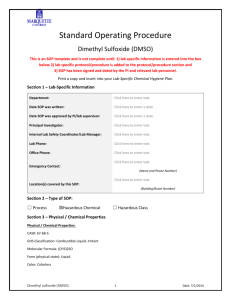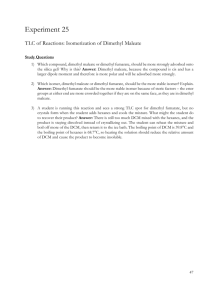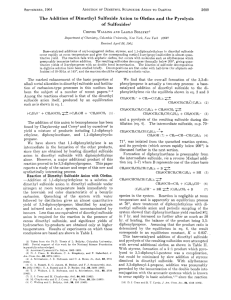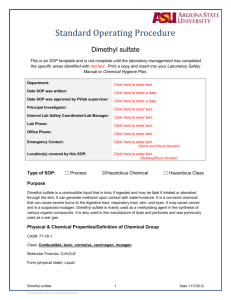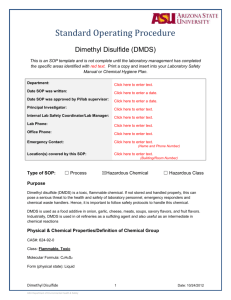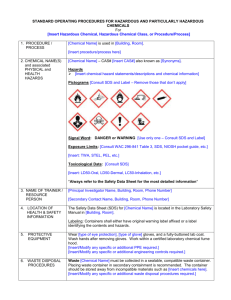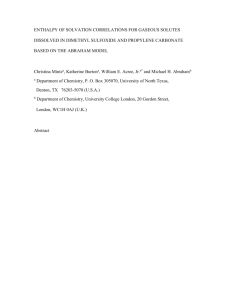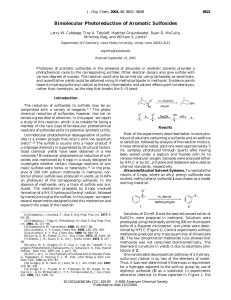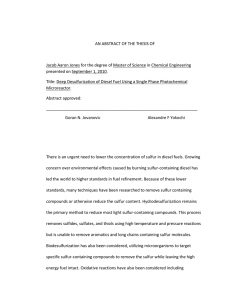Dimethyl Sulfoxide - WSU Environmental Health & Safety
advertisement
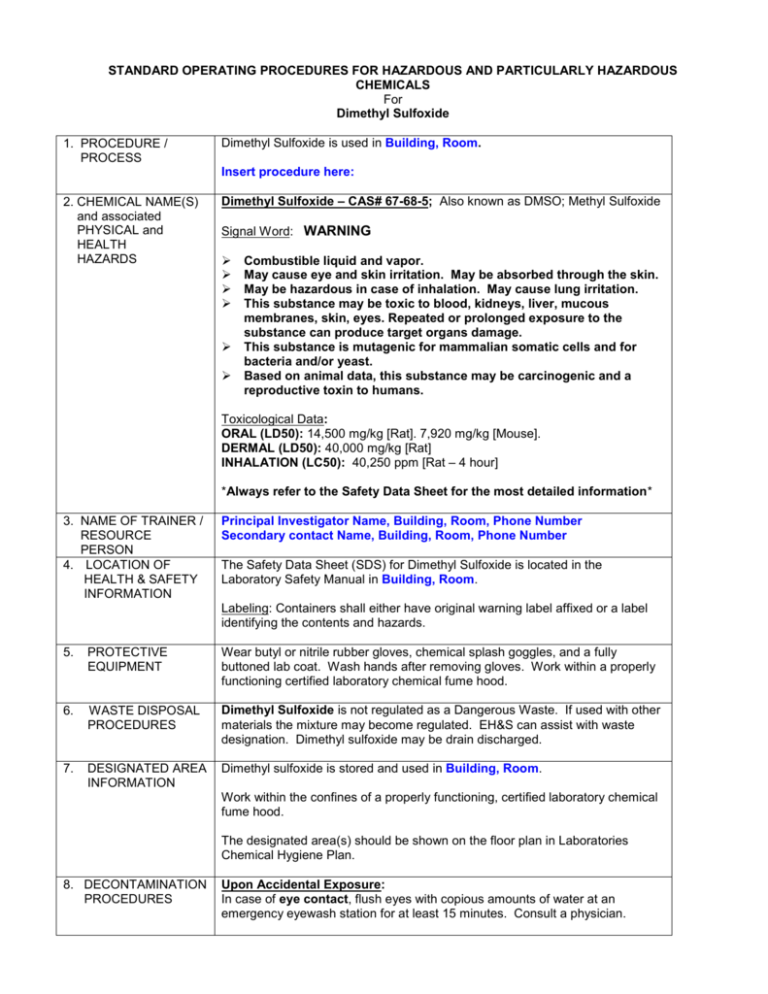
STANDARD OPERATING PROCEDURES FOR HAZARDOUS AND PARTICULARLY HAZARDOUS CHEMICALS For Dimethyl Sulfoxide 1. PROCEDURE / PROCESS Dimethyl Sulfoxide is used in Building, Room. Insert procedure here: 2. CHEMICAL NAME(S) and associated PHYSICAL and HEALTH HAZARDS Dimethyl Sulfoxide – CAS# 67-68-5; Also known as DMSO; Methyl Sulfoxide Signal Word: WARNING Combustible liquid and vapor. May cause eye and skin irritation. May be absorbed through the skin. May be hazardous in case of inhalation. May cause lung irritation. This substance may be toxic to blood, kidneys, liver, mucous membranes, skin, eyes. Repeated or prolonged exposure to the substance can produce target organs damage. This substance is mutagenic for mammalian somatic cells and for bacteria and/or yeast. Based on animal data, this substance may be carcinogenic and a reproductive toxin to humans. Toxicological Data: ORAL (LD50): 14,500 mg/kg [Rat]. 7,920 mg/kg [Mouse]. DERMAL (LD50): 40,000 mg/kg [Rat] INHALATION (LC50): 40,250 ppm [Rat – 4 hour] *Always refer to the Safety Data Sheet for the most detailed information* 3. NAME OF TRAINER / RESOURCE PERSON 4. LOCATION OF HEALTH & SAFETY INFORMATION Principal Investigator Name, Building, Room, Phone Number Secondary contact Name, Building, Room, Phone Number The Safety Data Sheet (SDS) for Dimethyl Sulfoxide is located in the Laboratory Safety Manual in Building, Room. Labeling: Containers shall either have original warning label affixed or a label identifying the contents and hazards. 5. PROTECTIVE EQUIPMENT Wear butyl or nitrile rubber gloves, chemical splash goggles, and a fully buttoned lab coat. Wash hands after removing gloves. Work within a properly functioning certified laboratory chemical fume hood. 6. WASTE DISPOSAL PROCEDURES Dimethyl Sulfoxide is not regulated as a Dangerous Waste. If used with other materials the mixture may become regulated. EH&S can assist with waste designation. Dimethyl sulfoxide may be drain discharged. 7. DESIGNATED AREA INFORMATION Dimethyl sulfoxide is stored and used in Building, Room. Work within the confines of a properly functioning, certified laboratory chemical fume hood. The designated area(s) should be shown on the floor plan in Laboratories Chemical Hygiene Plan. 8. DECONTAMINATION PROCEDURES Upon Accidental Exposure: In case of eye contact, flush eyes with copious amounts of water at an emergency eyewash station for at least 15 minutes. Consult a physician. In case of skin contact, flush skin with copious amounts of water for 15 minutes. For exposure over a large portion of the body, remove clothing and shoes and rinse thoroughly in an emergency shower for at least 15 minutes. Consult a physician. In case of inhalation, move person to fresh air and consult a physician. In case of ingestion, immediately seek medical attention and follow instructions on SDS. Upon Accidental Release: Large Spill: If a large amount of dimethyl dulfoxide is released, immediately evacuate, secure area and call 911 to contact EH&S. Small Spill: If a small amount of dimethyl sulfoxide is released (it can be cleaned up in 10 minutes) and you have been appropriately trained to clean it up, you may do so. Trained personnel should wear at the minimum butyl or nitrile rubber gloves, chemical splash goggles, and a fully buttoned lab coat. Additional PPE such as respirators may be necessary depending upon material and concentration. (Note: You must be medically cleared, fit tested, and enrolled in WSU’s respiratory protection program to wear a respirator). If it is necessary to use a respirator and personnel are not cleared to wear a respirator and not trained to appropriately clean up the spill, the employee should immediately evacuate, secure area, and call 911 to contact EH&S. Absorb with an inert dry material and place in an appropriate waste disposal container and dispose of as dangerous waste (see above WASTE DISPOSAL PROCEDURES). As with all accidents, report any exposure as soon as possible to your Principal Investigator or Supervisor. Additional health and safety information on dimethyl sulfoxide can be obtained by referring to the SDS or by calling the EH&S Office (335-3041). 9. SPECIAL STORAGE AND HANDLING PROCEDURES Store in a cool, dry, well-ventilated area away from sources of heat or ignition. Keep container tightly closed. Keep away from incompatible materials such as acid chlorides, phosphorus halides, strong acids, strong oxidizing agents, strong reducing agents and alkalis. Certification of Hazard Assessment Is this document a certification of Hazard Assessment for the processes identified within? Yes No If yes, provide the name of the person certifying the Hazard Assessment and the date it was performed: ____________________________________________________________________________________ Name Date The location of the Hazard Assessment is indicated in the document preceding this form. Certificate of Employee Training Name of person providing training for employees working with this process: ___________________________________________________________________________________ The following employees have been trained in when, where and how to use selected PPE, the maintenance, limitations and disposal of the PPE selected, and have demonstrated the correct use of the PPE selected on the reverse of this certification. Name Date Trained ________________________________________ _______________________________ ________________________________________ _______________________________ ________________________________________ _______________________________ ________________________________________ _______________________________ ________________________________________ _______________________________ ________________________________________ _______________________________ ________________________________________ _______________________________
